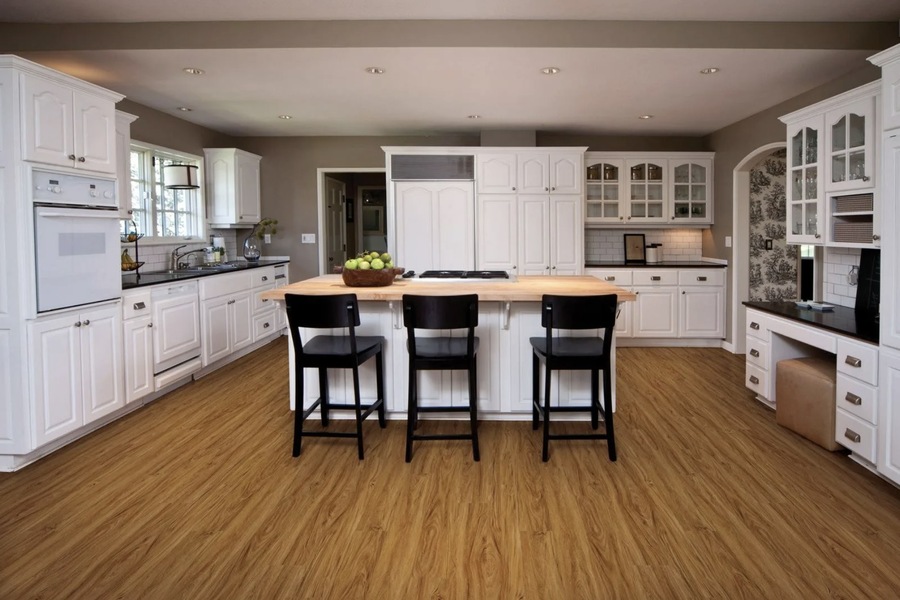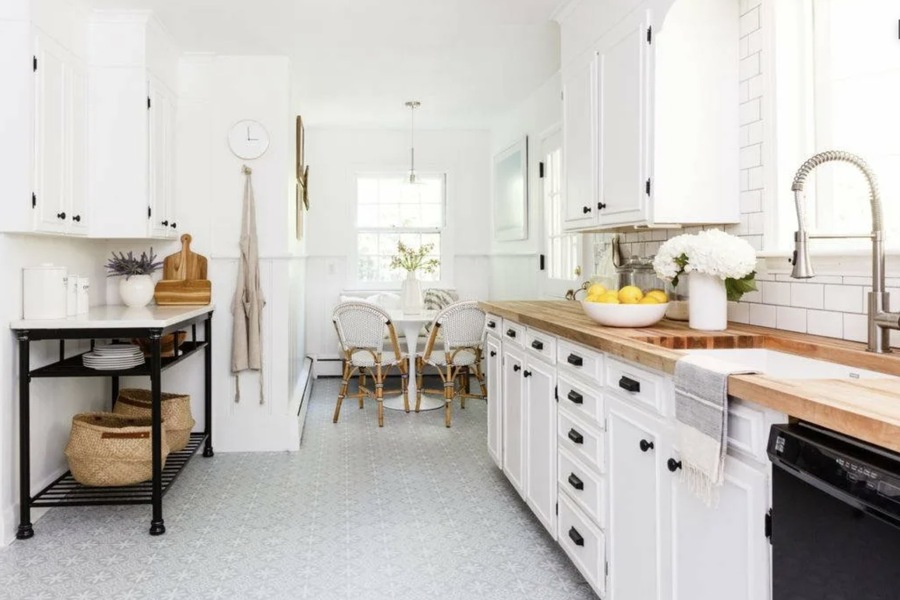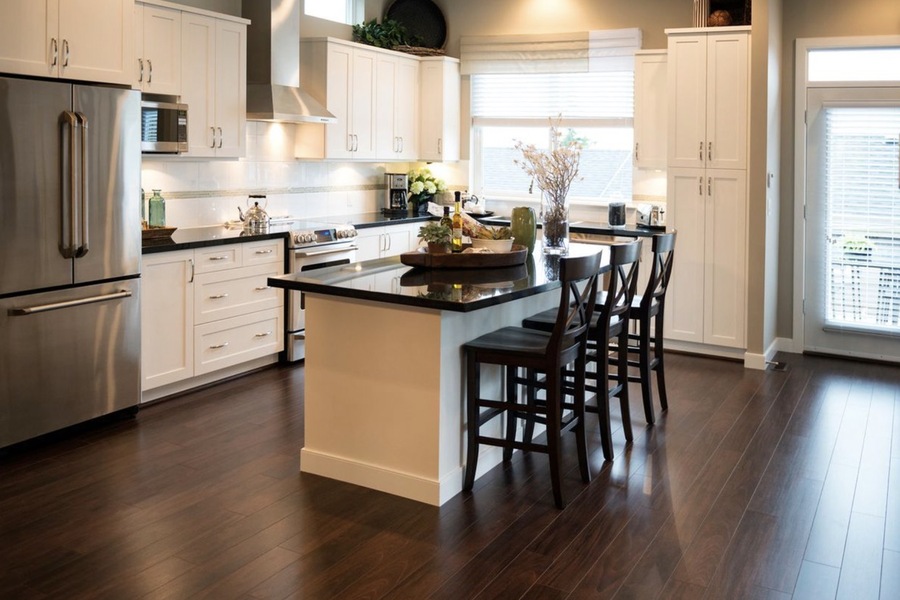The kitchen is often considered the heart of the home. It’s where meals are prepared, where families gather to share their day, and often where some of the most cherished household activities occur. Given the amount of time spent in the kitchen, ensuring that this space is both comfortable and convenient is crucial. One of the most significant aspects of kitchen comfort is the floor covering. A high-quality kitchen floor, particularly with the right choice of kitchen tiles is essential for various reasons, including practicality, wear resistance, moisture resistance, cleanliness, ease of care, and safety. In this article, we will explore these factors in detail and discuss the different types of floor kitchen tiles suitable for the kitchen.
Practicality
A practical kitchen floor is essential due to the room’s multifunctional nature. The kitchen serves as a place for cooking, eating, and often socializing. Therefore, the flooring should be practical, comfortable, and in harmony with the interior design. It should withstand the daily hustle and bustle, accommodate heavy foot traffic, and be easy to maintain. Practical flooring contributes to a seamless kitchen experience, allowing homeowners to move, cook, and clean without worrying about damaging the floor.
Wear Resistance
The kitchen floor needs to endure significant wear and tear. People walk around a lot in the kitchen, and heavy items like pots and pans can sometimes be dropped. Therefore, the flooring must be durable and resistant to damage to ensure it remains in good condition over time. High wear resistance ensures that the floor can handle the constant movement and occasional accidents that occur in a busy kitchen. This not only maintains the aesthetic appeal of the kitchen but also prolongs the lifespan of the flooring.
Moisture Resistance
Moisture resistance is a critical factor for kitchen flooring. Water and other liquids frequently spill on the kitchen floor, particularly near the sink and dining areas. A moisture-resistant floor prevents water damage and inhibits the growth of mold and mildew, which can compromise both the appearance and hygiene of the kitchen. Moisture-resistant flooring ensures that spills can be cleaned up quickly without leaving lasting damage, maintaining a safe and healthy environment for the family.

Cleanliness and Easy Maintenance
The kitchen floor is susceptible to spills and stains from food and cooking oils. Unlike textured floors that attract dirt, a smooth floor surface is easier to clean and less likely to harbor bacteria. High-quality kitchen flooring should be easy to maintain, ensuring it remains clean and hygienic with minimal effort. Easy-to-clean floors contribute to the overall cleanliness of the kitchen, making it easier to keep the space tidy and free from harmful germs and bacteria.
Safety
Safety is a paramount concern in the kitchen. The floor covering should provide adequate traction to prevent slips and falls, especially when wet. Choosing a non-slip material for kitchen flooring can significantly reduce the risk of accidents. Safety-oriented flooring options ensure that the kitchen is a secure environment for all family members, including children and the elderly, reducing the likelihood of injuries from slips and falls.
Types of Floor Tiles for the Kitchen
Tiles are a popular choice for kitchen flooring due to their durability, aesthetic appeal, and ease of maintenance. Here are some common types of floor tiles used in kitchens:
Ceramic Tiles
Ceramic tiles are a staple in kitchen flooring. They are available in a wide range of colors, textures, and designs. Ceramic tiles are low maintenance and resistant to water and stains. However, they can be fragile and may crack if a heavy object is dropped on them. Ceramic tiles are a versatile option, offering various design possibilities while ensuring practicality and ease of care.
Clinker Tiles
Clinker tiles are known for their durability and resistance to mechanical damage. They are often used for exterior cladding but are also suitable for kitchen flooring. Clinker tiles are limited in design options and typically come in small formats. Despite their limited design range, clinker tiles provide excellent durability and strength, making them a reliable choice for high-traffic kitchen areas.
Porcelain Tiles
Porcelain tiles are a type of ceramic tile that includes minerals and natural pigments. They are fired at high temperatures, making them as strong as natural granite. Porcelain tiles are highly durable and resistant to water, stains, and scratches. Their robustness and variety in design make them an excellent choice for kitchen flooring, combining both functionality and aesthetic appeal.
Quartz Vinyl Tiles
Quartz vinyl tiles are made from PVC and can contain up to 80% quartz sand. They are hard, durable, and less demanding on the subfloor. Quartz vinyl tiles offer a practical and stylish solution for kitchen flooring. Their unique composition makes them resilient and versatile, suitable for various kitchen designs while ensuring durability and ease of maintenance.
Pressed Tiles
Pressed tiles are created through a process of vibration and compaction, resulting in increased strength. They are suitable for rustic and country-style interiors and offer a unique aesthetic appeal. Pressed tiles add a distinctive charm to the kitchen, enhancing the interior design while providing robust flooring that withstands the demands of a busy kitchen environment.
Glass Tiles
Glass tiles are available in various finishes, including glossy, matte, translucent, and colored. While they are often used for decorative purposes, such as backsplashes, they can be expensive and impractical for covering large areas. Glass tiles bring a touch of elegance and modernity to the kitchen, perfect for accentuating specific areas and adding visual interest to the space.
Stone Tiles
Stone tiles provide a luxurious and timeless look to any kitchen. They are suitable for floors, walls, and areas behind appliances. Each stone tile has a unique texture, enhancing the kitchen’s overall aesthetic. Stone tiles are a premium choice, offering natural beauty and exceptional durability, ideal for creating a sophisticated and enduring kitchen design.

Factors to Consider When Choosing Kitchen Tiles
When selecting tiles for the kitchen, several factors should be considered to ensure the best choice:
- Appearance: The tiles should be free from defects, such as chips and cracks, to maintain their appearance and functionality over time. Quality control is essential to ensure that the tiles look good and perform well in the long run.
- Brand Reputation: Opt for tiles from well-known manufacturers to ensure high quality and reliability. Reputable brands are more likely to offer products that meet high standards of durability and design.
- Texture: Matte finishes are ideal for kitchen floors as they provide better traction and reduce the risk of slipping. The texture of the tiles should complement the overall design while enhancing safety and practicality.
- Color: The tile color should complement the kitchen’s interior design. Light-colored tiles are less likely to show chips and cracks. The color scheme should be cohesive with the kitchen’s decor, creating a harmonious and visually appealing space.
- Wear Resistance: Choose tiles with a high wear resistance class (3-5 on the PEI scale or class 5 according to GOST) for longevity. High wear resistance ensures that the tiles can withstand the demands of a busy kitchen, maintaining their appearance and functionality over time.
- Slip Resistance: Look for tiles with a friction coefficient of 0.75 to enhance safety. Slip-resistant tiles are crucial for preventing accidents, especially in a kitchen where spills are common.
- Chemical Resistance: Kitchen tiles should withstand exposure to household chemicals. Class A or AA tiles are recommended. Chemical resistance ensures that the tiles can endure regular cleaning without being damaged, maintaining their appearance and hygiene.
- Water Absorption: Low-porosity tiles are preferable for kitchen floors as they are less likely to absorb moisture. Tiles with low water absorption rates prevent water damage and are easier to clean, making them ideal for kitchen environments.
- UV Resistance: Ensure the tiles have a “sun” symbol on the packaging, indicating resistance to fading from UV exposure. UV-resistant tiles maintain their color and appearance even with prolonged exposure to sunlight, ensuring a long-lasting and vibrant kitchen floor.
Conclusion
Investing in high-quality kitchen flooring is crucial for creating a comfortable, practical, and safe environment. Whether you opt for ceramic, porcelain, or stone tiles, the key is to choose materials that offer durability, ease of maintenance, and aesthetic appeal. By considering the factors outlined above, you can ensure that your kitchen floor remains functional and beautiful for years to come. High-quality flooring not only enhances the kitchen’s usability but also adds value to your home, making it a worthwhile investment for any homeowner.

Hiking addict, shiba-inu lover, record lover, Swiss design-head and New School grad. Acting at the crossroads of modernism and sustainability to craft an inspiring, compelling and authentic brand narrative.


